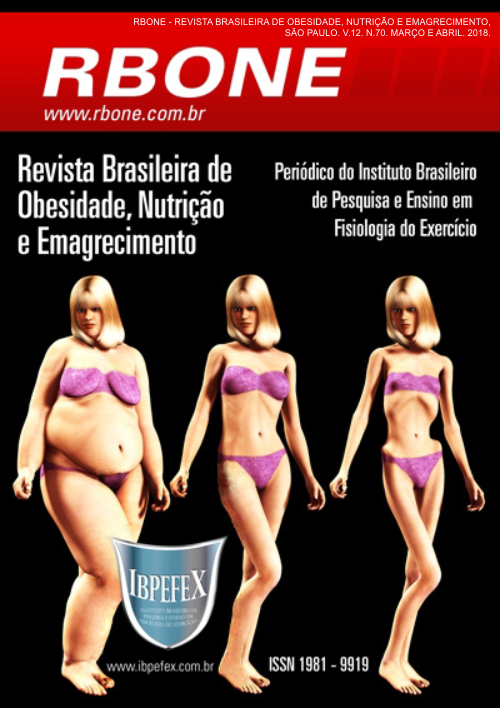Nutritional status and risk of cardiovascular disease in tele-care operators
Abstract
Objective: To evaluate the nutritional status and risk of cardiovascular disease among employees of a health care center in the city of São Paulo. Methodology: This is a cross-sectional study that evaluated 54 telemarketing operators, with a mean age of 37 years, of both sexes, employees of a telemarketing company. For the characterization of the individuals, a questionnaire containing data on age, sex, schooling, telemarketing work time, practice of physical activities, alcoholism, smoking and presence of chronic diseases was applied. The nutritional status of the individuals was analyzed by weight, height, body mass index, waist circumference and conicity index. Results: It was possible to observe high mean BMI in the employees and that the majority of the women were classified as overweight (15%) and obesity (19%) in relation to this index. Regarding the risk of developing cardiovascular diseases, it was verified that 68% (n = 37) of the participants were considered risk individuals according to the waist circumference and the conicity index. Conclusion: Based on the results found in the study, we note the importance of developing health promotion actions for these workers.
References
-Biasi, D.; Souza, F. A. P. o teletrabalho e a qualidade de vida nos contact centers. Revista Gerenciais. Vol. 5. Núm. 2. p. 25-33. 2006.
-Cristofoletti, M.F. Avaliação do estado nutricional de operadores de telemarketing submetidos a três turnos fixos de trabalho. Faculdade de Saúde Pública da Universidade de São Paulo, 2003.
-Cristofoletti, M. F.; Souza, M. F. M.; Cardoso, M. A.; Rocha, L.E. Prevalência de sobrepeso, obesidade e obesidade abdominal em operadores de duas centrais de atendimento telefônico de São Paulo. Saúde, Ética & Justiça. Vol. 11. Num. 1/2. p. 19-28. 2006.
-Grossl, T.; Augustemak, L. R.; Karasiak, F.C. Relação entre a gordura corporal e indicadores antropométricos em adultos frequentadores de academia. Vol. 6. Num. 2. p. 35-45. 2010.
-Guimarães, I.C.B.; e colaboradores. Pressão Arterial: Efeito do Índice de Massa Corporal e da Circunferência Abdominal em Adolescentes, Arq. Bras. Cardiol. Vol. 90. Num. 6. p. 426-432. 2008.
-INEP, Instituto Nacional de Estudos e Pesquisas Educacionais Anísio Teixeira. Evolução da Educação Superior. 2016. Disponível em: <http://portal.inep.gov.br/web/censo-da-educacao-superior/evolucao-1980-a-2007> Acessado em: 29/062016.
-Lima, F.B. Stress qualidade de vida, prazer e sofrimento no trabalho de call center. Dissertação de Mestrado em Psicologia do Centro de Ciências da Vida. PUC-Campinas. 2004.
-Pitanga, F. J. G.; Lessa, I. Sensibilidade e especificidade do índice de conicidade como discriminador do risco coronariano de adultos em Salvador, Brasil. Rev. Bras. Epidemiol. Vol. 7. Num. 3. p. 259-268. 2004.
-Ricci, M. G.; Rachid, A. Relações de trabalho no serviço de teleatendimento. Gest. Prod. Vol. 20. Num. 1. p. 192-203. 2013.
-Zilioto, D. M.; Oliveira, O. A Organização do Trabalho em CallCenters: Implicações na Saúde Mental dos Operadores. Revista Psicologia: Organizações e Trabalho. Vol. 14. Num. 2. p. 169-179. 2014.
Authors who publish in this journal agree to the following terms:
- Authors retain the copyright and grant the journal the right of first publication, with work simultaneously licensed under the Creative Commons Attribution License BY-NC which allows the sharing of the work with acknowledgment of the authorship of the work and initial publication in this journal.
- Authors are authorized to enter into additional contracts separately for non-exclusive distribution of the version of the work published in this journal (eg, publishing in institutional repository or book chapter), with acknowledgment of authorship and initial publication in this journal.
- Authors are allowed and encouraged to post and distribute their work online (eg, in institutional repositories or on their personal page) at any point before or during the editorial process, as this can bring about productive change as well as increase impact and impact. citation of published work (See The Effect of Free Access).






